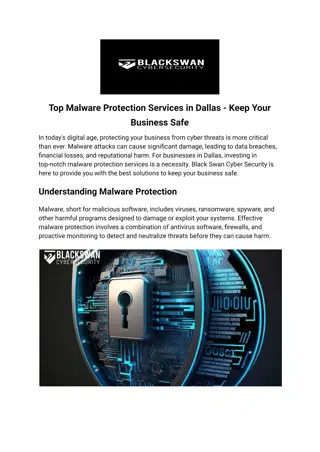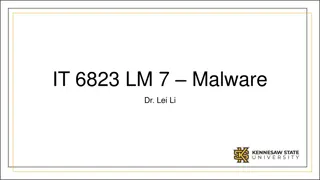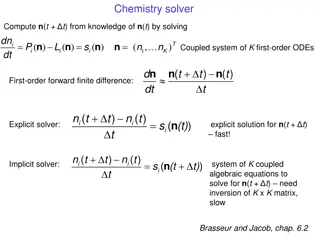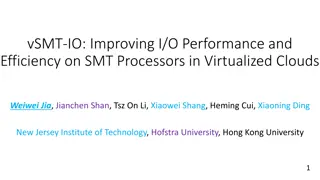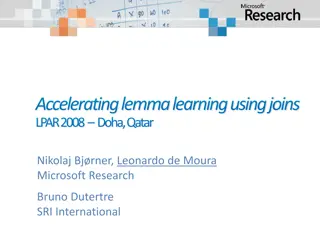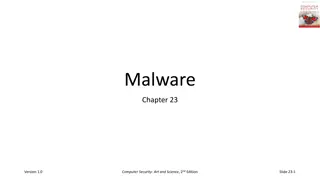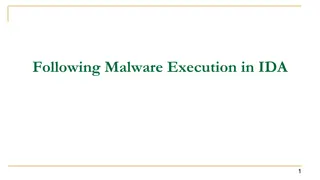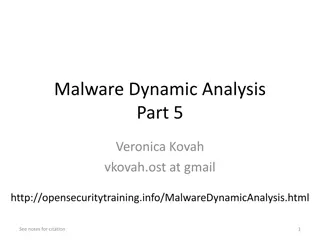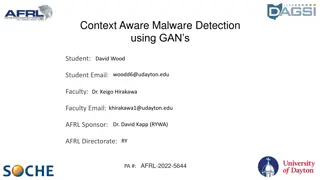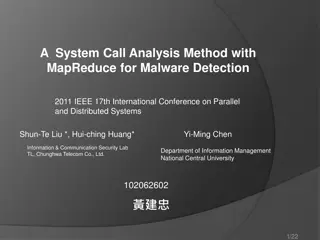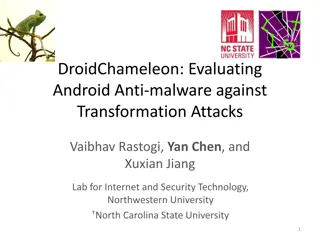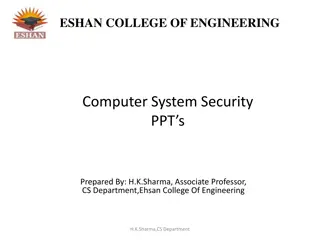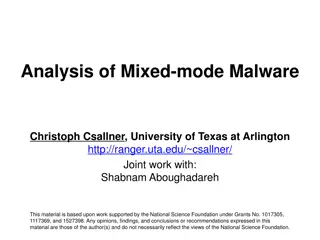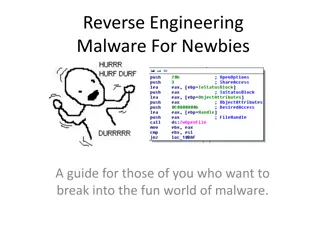Exploring SMT Solvers for Malware Unpacking
In this informative content, we delve into the world of malware analysis, binary packers, and the challenges posed by obfuscation techniques. The article discusses tools like UPX and Themida, as well as the complexities of virtualization and handler obfuscation in unpacking malware. Understanding these methods is crucial for effective malware analysis and detection.
Download Presentation

Please find below an Image/Link to download the presentation.
The content on the website is provided AS IS for your information and personal use only. It may not be sold, licensed, or shared on other websites without obtaining consent from the author. Download presentation by click this link. If you encounter any issues during the download, it is possible that the publisher has removed the file from their server.
E N D
Presentation Transcript
SMT Solvers for Malware Unpacking 8 July 2013
Authors and thanks Ian Blumenfeld Roberta Faux Paul Li Work overseen by Mark Raugas Director CyberPoint Labs Special thanks to Levent Erkok for technical help with the SBV library 2
Malware analysis We must understand the behavior of a piece of malware. Obfuscation techniques make manual analysis time-consuming. Skilled malware analyst time is expensive. 3
Binary packers Transform a binary program into a new program that has the same functionality Insert unpacking code that restores the original code in memory and then jumps to it Use additional techniques to deter analysis Range from freeware to expensive commercial products to custom packers written by malware authors 4
Virtualization Themida embeds a virtual processor within the packed binary. Certain instructions are converted to byte-code for that processor. Each byte-code instruction is interpreted by a handler. Even the handlers are obfuscated. Different runs of the packer result in different handlers. 7
A (simple) handler push dword 0x4a99 mov [esp],esi add ecx,eax mov [esp],ebx mov [esp],ecx mov eax,[esp] push esp mov ecx,esp push esi pop dword [esp] add ecx,0x4 mov esi,esp push edx push dword 0x504a add esi,0x4 mov edx,0x4 mov [esp],ebx add esi,byte +0x4 add [esp+0x4],edx mov [esp],eax xor esi,[esp] pop edx push ecx xor [esp],esi push dword [esp] mov ecx,0x4 xor esi,[esp] pop edx mov eax,ecx mov esp,[esp] push edx mov ecx,[esp] xchg ecx,[esp] mov [esp],ebx add esp,0x4 pop esp 8
Complications Handlers may be much more complex than the example, and not end in the real instruction. Some handlers run on byte-code encrypted with a special constant. Obfuscation techniques for handlers may be random and handlers are repeated. 9
Symbolic simulation CyberPoint has written a Haskell library to symbolically simulate handlers. We use the open-source SBV library to provide a generic API to hook our code into SMT solvers. CVC4 Z3 Yices Boolector We model our machine using bit-vector and uninterpreted function theories We can use SMT to prove properties about the handler code. 10
Deobfuscating simple handlers Compile a list of reference handlers: Homegrown rewriter Manual analysis Examples from the literature Use trace tools to locate handlers in the virtual processor Use symbolic simulation and SMT solver to try to prove equivalence of an isolated handler to each reference handler 11
Results on simple handlers On purely symbolic machine state identification takes 5 minutes. By intelligently concretizing certain values to reduce to candidates, simpler handlers can be identified in about 5 seconds. These numbers make use of the embarrassingly parallel nature of the problem. Results without parallelization in the following chart: 12
Obfuscation constants Constants are used to encrypt using a variety of patterns Patterns are determined by by trying prove possible equivalence on the state register EBX Once pattern is obtained, can use SMT for function inversion to discover the constant Preliminary success in simple handlers that use constants, though all constants recovered so far can also be found through other means 14
Constants to encrypt the bytecode stream dispatch: lodsb ; loads the next byte into AL, ; then advances the bytecode pointer ESI add al, bl ; bytecode obfuscation xor al, 0xe8 ; add al, 0x47 ; sub bl, al ; movzx eax, al ; zero-extend the handler index jmp [edi+eax*4] ; jump to handler ; in most cases the end of the ; handler jumps back to "dispatch" 15
Stolen code Understanding which API calls are made is critical information for a malware analyst. Sometimes the packer will steal the first several instructions from an API function. It: Obfuscates them Inserts them into the caller Eventually jumps to an address to get it back to the API function Wastes analyst time on a normally simple part of their task 16
Stolen code example: original API function ;; kernel32!InterlockedIncrement 776fc3b0: 8bff mov edi, edi 776fc3b2: 55 push ebp 776fc3b3: 8bec mov ebp, esp 776fc3b5: 5d pop ebp 776fc3b6: eb88 jmp 0x776fc340 . . . . . . 17
Stolen code example: obfuscation in the caller 10a00000: 8bff mov edi, edi 10a00011: 95 xchg ebp, eax 10a00012: 50 push eax 10a00013: 52 push edx 10a00029: 0f31 rdtsc 10a0002b: 60 pushad 10a0002c: 8bca mov ecx, edx 10a0002e: 50 push eax 10a0002f: 52 push edx 10a00030: 0f31 rdtsc 10a00032: 5a pop edx 10a00033: 58 pop eax 10a00034: 61 popad 10a00035: 5a pop edx 10a00036: 58 pop eax 10a00037: 50 push eax 10a00038: 50 push eax 10a00039: 52 push edx 10a0004f: 0f31 rdtsc 10a00062: 5a pop edx 10a00063: 58 pop eax 10a00064: 95 xchg ebp, eax 10a00073: 8bec mov ebp, esp 10a00075: 50 push eax 10a00076: 52 push edx 10a00077: 60 pushad 10a00078: 66bb707c mov bx, 0x7c70 10a0007c: e814000000 call 0x10a00095 10a00095: 58 pop eax 10a00096: 61 popad 10a00097: 0f31 rdtsc 10a00099: 60 pushad 10a0009a: 50 push eax 10a0009b: 5f pop edi 10a0009c: 0fb7cb movzx ecx, bx 10a0009f: 61 popad 10a000a0: 5a pop edx 10a000a1: 58 pop eax 10a000a2: 5d pop ebp 10a000a3: 60 pushad 10a000a4: 8bc7 mov eax, edi 10a000a6: 9c pushfd 10a000b4: 80dc56 sbb ah, 0x56 10a000c8: 9d popfd 10a000c9: 61 popad 10a000ca: e9e7c2cf66 jmp 0x776fc3b6 18
Results on stolen code If we know a priori which code is stolen, we can loop over possible API functions to prove equivalence For full generality, we would need to figure out how many instructions from the API calls are stolen Proofs do work, but limited advantages over other techniques Symbolic termination can be a problem 19
Comparisons to prior work Work by Rolles in 2012 suggests using syntactic optimization techniques to undo obfuscation, then using SMT solvers to check the correctness of the optimization. Our research shows that it is possible to remove the need for a syntactic optimizer. The SMT solver itself can do those tasks, albeit much slower. There are potential advantages to an SMT only based approach, especially if more complicated obfuscation techniques are employed. 20
Moving forward Given the initial successes, we should do real comparisons of SMT based approaches with others? Can we use our work to actually rewrite the binary to a deobfuscated form? How can we expand the work on Themida to other packers: VMProtect Enigma Custom packers What other role can SMT solvers play in the world of malware analysis? 21
Questions? 22
Thank you, have a great day! 23


